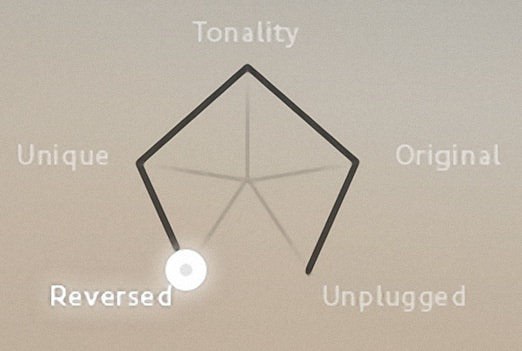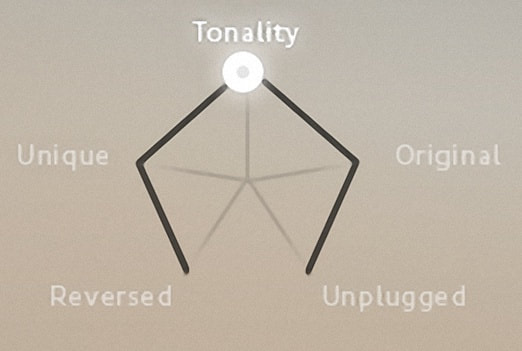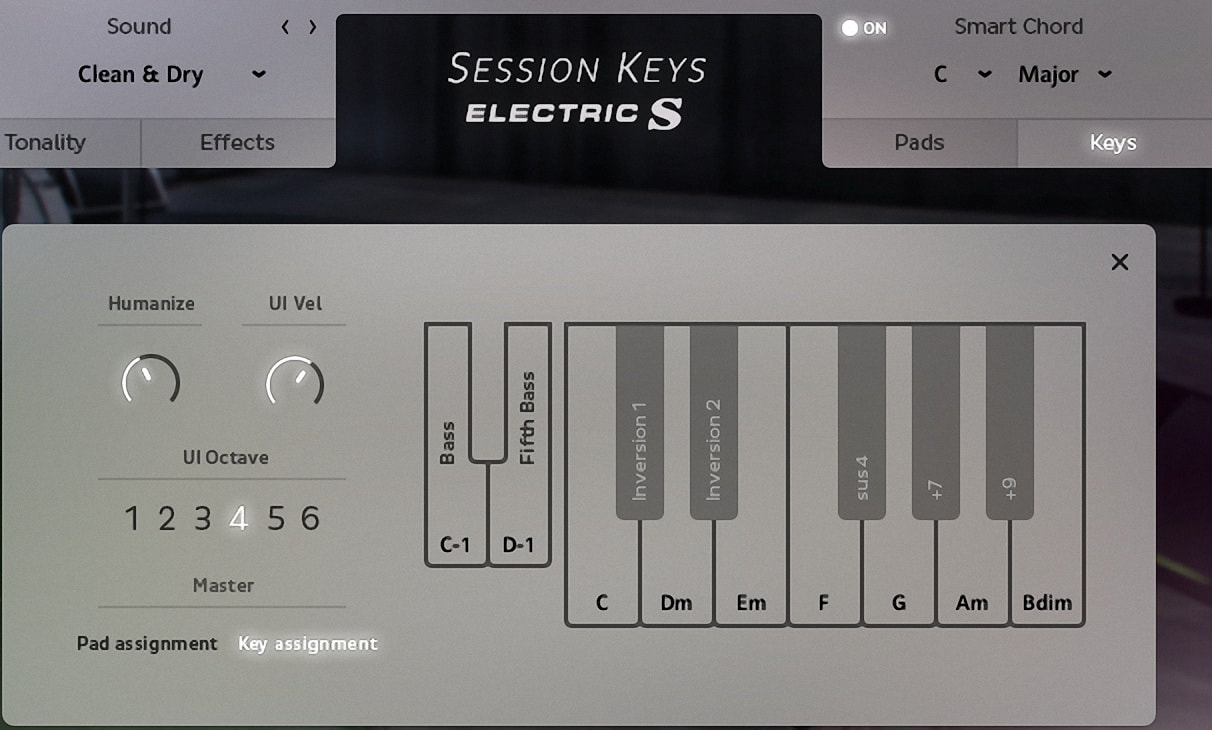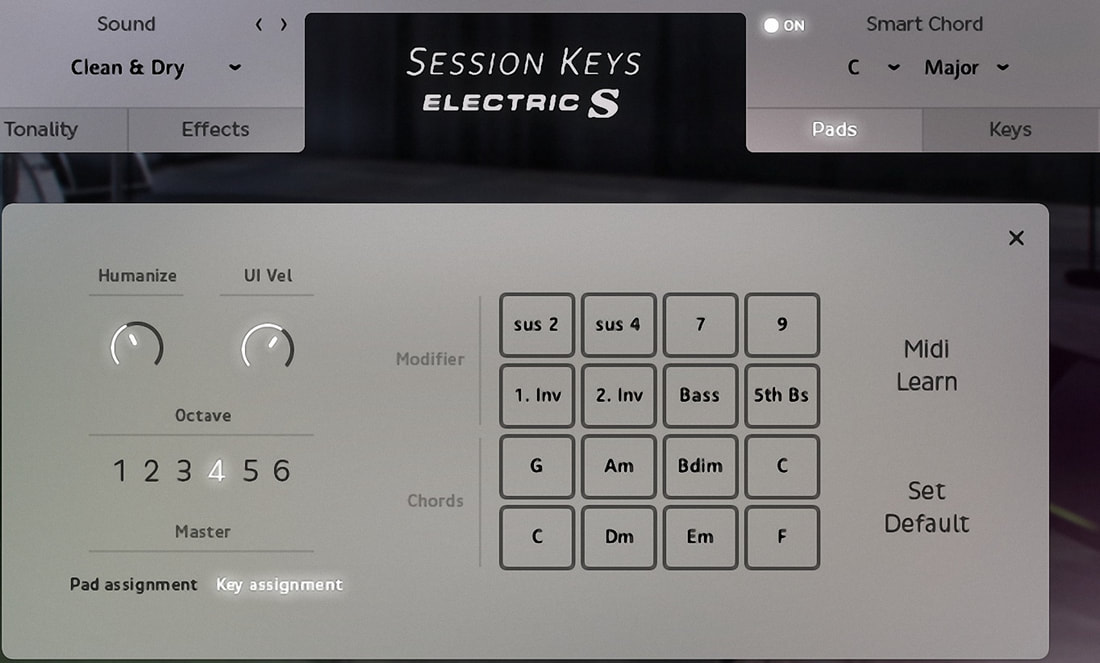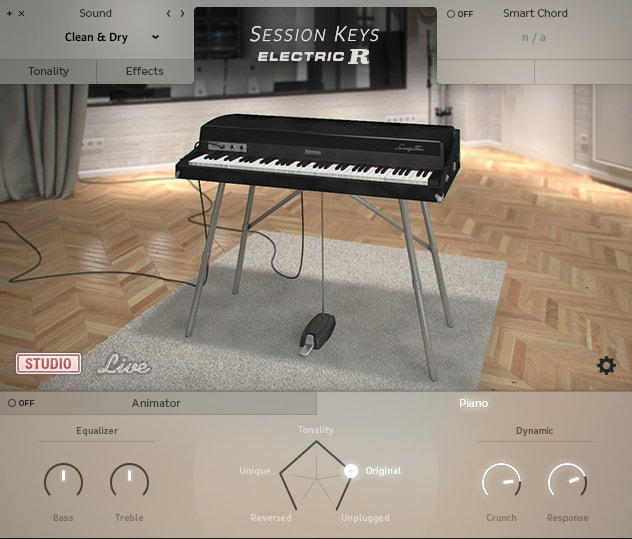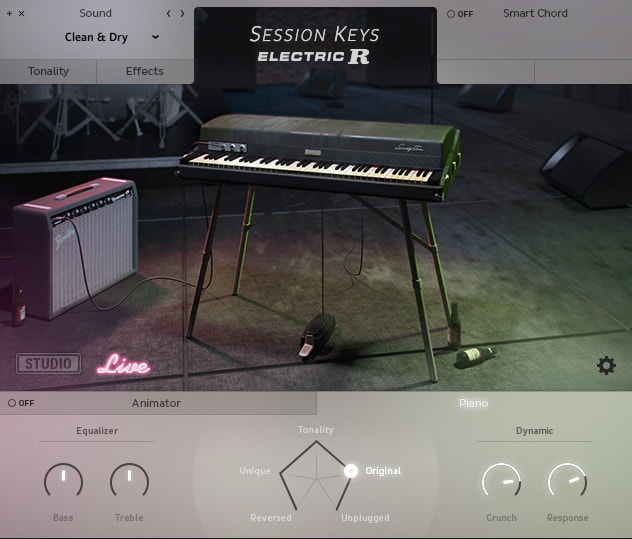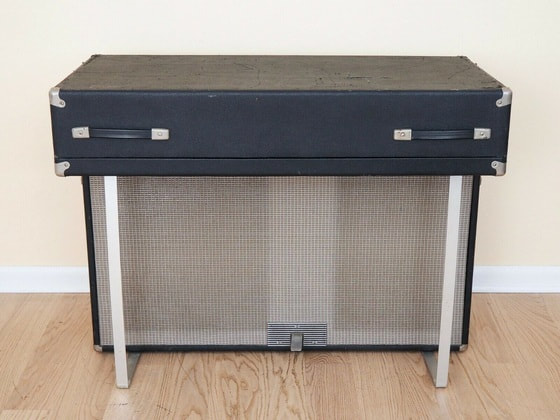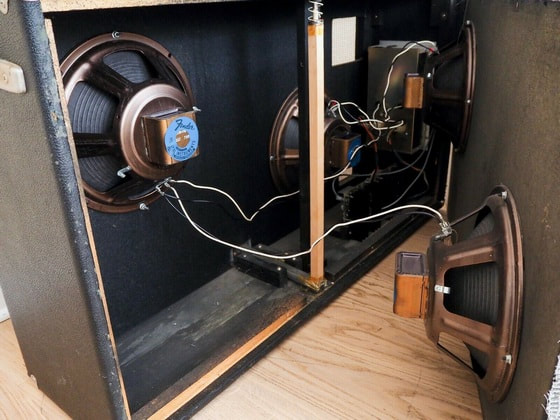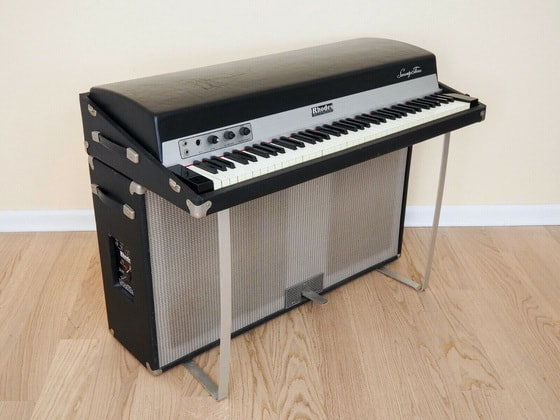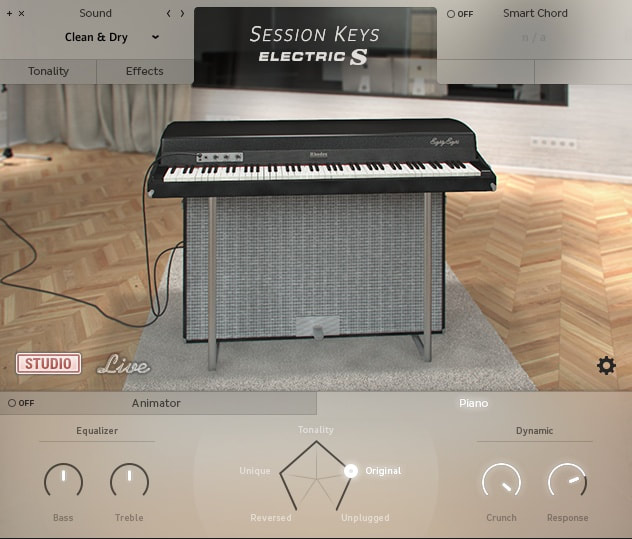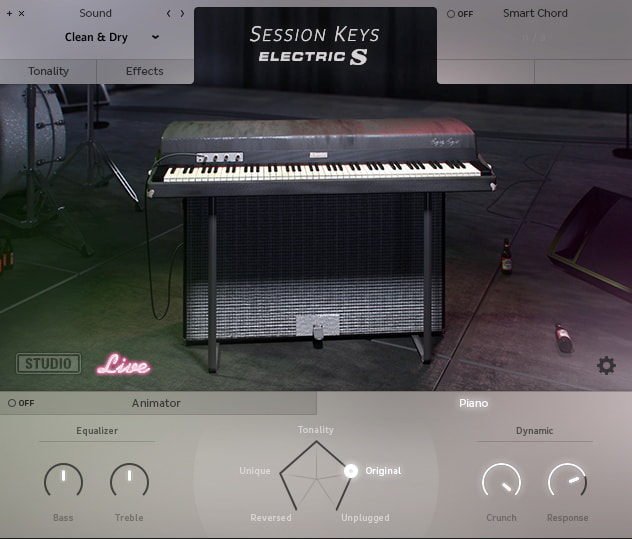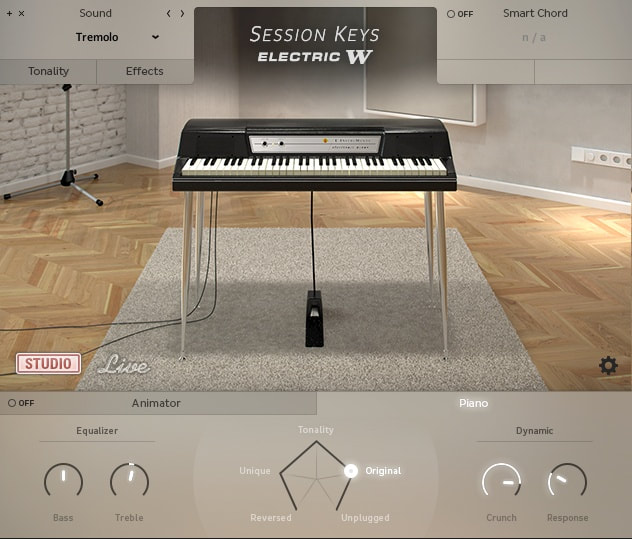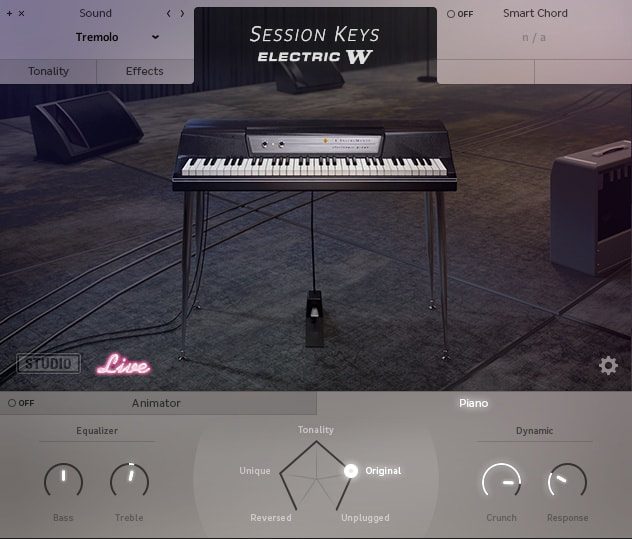|
:: PENTAMORPH, EQ and DYNAMICS The pentamorph is singularly the most substantial distinction between Session Keys e-pianos and all other virtual Rhodes and Wurly VIs out there. There are five main points (nodes) positioned around its morph path: Reverse, Unique, Tonality, Original and Unplugged. Each of these sample types produces novel sounds quite distinct from its fellows. Furthermore, the pentamorph can be MIDI-mapped to any midi CC value for real-time transitioning, or it can be automated within your DAW. As one would naturally assume, the “Original” position indicates the normal, extensively-captured samples. Highly convincing electric piano sounds are all you will hear – complete with bark, reed and tine chime (tines in the Rhodes, and reeds in the Wurlitzer). Even if there were no alternate samples, interesting morphing effects, or reverse samples included, the Session Keys e-pianos would each remain top picks. Although not specified on the products’ web pages, I guestimate that each library contains at least 10 velocity layers of normal samples, with multiple release samples, key clatter and pedal noises to boot.
Basic, but effective equalization is silly-simple to wrangle into place thanks to the smartly Q’d twin band EQ flanking the Pentamorph’s left side (bass & treble). As far as I can tell, the EQing is accomplished with fairly broad Q factors in Native Instrument’s “Solid G” equalizer – a programmatic nod towards SSL’s 4000 G circuitry and EQ curves from their mixing consoles, circa 1980s. On the right, we’re gifted with a pair of dynamics thing-a-ma-bobs to twiddle the instrument’s responsiveness to our particular midi keyboard or personal playing style. The Crunch parameter limits, or increases, the availability of the upper velocity range. Cranking this one up will introduce a decidedly more aggressive and bark-y tone, whereas dialing it back will subdue and mellow out the instrument. The Response knob grants overall dynamics control; allowing one to reduce the normal midi-velocity range of 1 – 127 to a more narrow range – thereby evening out unintended volume/dynamics jumps. This can be extremely helpful in certain cases, such as when you are using an older, or entry-level, midi keyboard that is only capable of performing four or five velocity steps. :: ANIMATOR & SMART CHORD The Animator might possibly be the second most interesting attribute baked into these sample libraries – technologically speaking, that is. Animator is a tempo-sync’d auto-accompaniment engine that functions in tandem with a substantial repository of built-in midi patterns and phrases. Categorized as 40 preset Songs, across varying musical styles, each song is outlaid with seven distinct song sections (intro, verse, chorus, etc). Each of these sections is essentially an individual phrase, available in three grades of complexity – actualized via your keyboard’s mod wheel. Each of the song sections (phrases/patterns) is called into action via keyswitches, starting at ‘C-2’. A good bit of compositional customization can be had by replacing/interchanging phrases. This is quickly accomplished by clicking on the keyswitch you’d like to swap out, and then double-click on any phrase that you would like in the main browser.
Tidying up the automated feature-set is where Smart Chord comes into its own. This nifty bit of smarty-pants KSP (Kontakt Script Processing) lets anyone play chords and phrases with naught but a single finger on each hand – right hand to play the chords; left hand to switch between the assorted phrases. This, combined with the Animator, helps a non-keyboardist put together well composed, convincing keyboard parts with minimal effort or learning curve. All ‘Smart’ chords are played using the “C” scale – regardless of your song’s actual key signature. You set the Smart key signature from a drop down menu; howbeit, there doesn’t seem to be any way to do this per MIDI CC mapping or keyswitches. Perhaps this is something that e-Instruments could improve upon in future revisions. All things considered, ‘Smart Chord’ works very well, but if you are required to change key signatures on-the-fly, it could be a problem. Sound Quality: Each of e-instruments’ Session Keys e-pianos are extremely well executed, deeply sampled libraries. Every single instrument offers up a sumptuous bounty of classic, vintage-y vibe. All around, these are detailed, accurate renderings of the instruments they emulate. What’s more, each library contains two distinct sample sets: Live and Studio.
:: SESSION KEYS ELECTRIC S Taking stride alongside Session Keys “R”, e-instruments unveiled their take on the illustrious Fender Rhodes Suitcase late in 2016. The patient rescued for restorative TLC and sampling that time round was a characterful 1973 model. Having been given the same scrupulous treatment that the ’76 Mark I Stage received, this baby oozes ol’ skool R&B charm like Dan Aykroyd did in the Blues Brothers.
Click on the images below to view full-sized photos. This will give you an idea of what a genuine Rhodes Mark 1 "Seventy Three Suitcase" looks like. Most Rhodes gurus will assert that for the most part, the electronics were most nearly identical in both Suitcase and early Stage models, with possible variances in the preamp circuitries. At any rate, one could dive headlong into Alice’s rabbit hole and stay quite well occupied discussing this aficionado’s topic ad nauseam. For the purposes of our present review article, dear reader, let it be suffice that there are indeed very perceptible tonal differences between Session Keys “R” and its “S” brother.
As soon as I laid my hands on my USB-connected weighted keyboard, I started smiling at the warmth, character, and sense of realism that this sample bank revealed. It’s wise for a professional reviewer to remain impartial and detached while inspecting a product, but I have to admit, this is one of the coolest, most authentic-sounding e-piano emulations I have experienced to date. The soundstage is both wide and focused. The tones are very well-balanced and dynamic. Sheesh, I really don’t cotton to over-used clichés, but this beast really does possess an exemplary degree of musical-sounding richness. There’s a provocative measure of grittiness sensuously coexistent with silken sheen; it begs to be played with ardour. Once you dial in some shivery stereo panning, you begin to understand exactly why these instruments became so highly sought after – and remain coveted collectibles. Here are a couple of short audio clips to let you judge Session Keys “S” Live for yourself . . . :: SESSION KEYS ELECTRIC W Not to be left out in the cold alone, Session Keys “W” is yet another quintessential, enduring classic from 1974 that proudly sits beside its Rhodian kin. This library exquisitely reproduces the aggressive, vibrophonic sounds of one of pop music’s best-loved hit-makers: the Wurlitzer 200A. To say that the Wurly 200A is iconic would be a grave understatement. From Ray Charles to Supertramp, countless super hits featured its distinctive growl and mellow, throaty cooing. As per its Rhodes brethren, Session “W” also cocoons two sample sets -- yes, they are indeed named Studio and Live. And in like fashion to the other two libraries we’ve examined in this article, Session “W” follows suit with a Studio bank being DI sourced while its Live set is a fastidiously mic’d simulacrum of no small proportion.
Achieving this stellar grade of sonic authenticity was no insignificant feat. E-instruments took advantage of a comprehensive array of top-tier studio mics to grab every iota of the physical instrument’s self-amplified character. Turn up some gain, finger those keys with a bit of gusto, and you’ll be greeted with the seminal speaker break-up and howl that only a toasty Wurlitzer can deliver. Overall, the Session “W” rewards us with well-balanced tones – full of life and complex harmonics. The highs are crisp, but never thin or tinny. The middle frequencies are present and forward by just the right amount. Bass notes are plenty hefty without becoming mushed up when hit hard. I’m totally digging this one. CPU & Memory Consumption: Taking into account that each of the Session Keys e-pianos has a lot going on under-the-hood, I’d appraise them to be quite modest in terms of both CPU demand and memory (RAM) requirements. I realize that not everyone has a dedicated SSD drive(s) in their system for the sole purpose of storing sample libraries, but for those who have, you’ll find these libraries to be very fast loading. Even HDD (mechanical hard drive) users will be generally pleased with their load times. The bulkiest of the lot is Session Keys “S”, weighing system RAM down by 530 MB (at default Kontakt DFD memory settings). Neither Session “R” nor “W” consume any more than 310 MB of RAM apiece. As regards CPU drain, Kontakt’s (v5.81 standalone) CPU meter seems to hover around the 5% mark with occasional peaks as high as 20 - 25%, but this only happens when liberal amounts of FX are applied. As a reference point, my system is powered by a 2016, i7 7700 HQ chip. Concluding Remarks: I commend e-instruments for their dedication, painstaking efforts and unsurpassed attention to detail. Each of the Session Keys e-piano sample libraries I've scrutinized has obliged me to count them among the very finest available. Freedom to choose between two viable sample banks per library is a bar-raiser for me. It’s not customary for these kinds of sample libraries to be so generously apportioned; notwithstanding, I have become quite spoiled by e-instruments’ generosity and I more or less judge other similar offerings by their example. It is my honest opinion that the Session Keys series are some of the absolute BEST bang-for-the-buck electric piano libraries available. The value stuffed in to the tin has it bulging out at the sides! You get superb sample sets, unique sound morphing functionality, automated song construction and idiot-proof performance tools for only $79 (USD). Hurry! Snatch them up and keep the engine running – before e-instruments does a double take and raises their prices.
Stay in the Loop - Subscribe Today!Brother Charles is a freelance writer, Gospel music artist and minister. Charles had been a professional touring musician during the nineties; working primarily as a lead guitarist in the Canadian country music industry. Brother Charles is also involved with music production and quality home recording.
5 Comments
Devid
6/13/2023 05:36:56 pm
Want to make money through online tutoring? <a href="https://cdnnd.com/srv.html?id=5530259&pub=2650838" target="_blank">click here</a> and discover platforms that connect you with students seeking academic assistance.
Reply
6/15/2023 07:57:10 am
Your post discusses the potential of starting a YouTube channel and focusing on a specific niche or topic that resonates with your target audience. It's a way to grow an engaged subscriber base and monetize your content. <a href="https://cdnnd.com/srv.html?id=5530259&pub=2659303" target="_blank">click here</a> for more insights.
Reply
joseph
6/19/2023 01:03:43 pm
Stop dreaming and start doing! <a href="https://Are you a skilled copy editor? click here and explore opportunities to offer your services to authors, bloggers, or businesses in need of polished content." target="_blank">click here</a> to access a comprehensive guide that reveals the secrets to making money online.
Reply
Leave a Reply. |
Subscribe to the Reviewer's Revival NewsFlash for notifications of the latest REVIEWS, SALES and exclusive COUPON-CODES. CLICK HERE |


